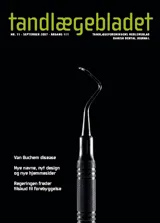Van Buchem disease. Udredning og kæbekirurgisk behandling af formodet tilfælde hos en ung kvindelig patient
Van Buchem disease, også kaldet generaliseret kortikal hyperostose, tilhører gruppen af kraniotubulære knoglesygdomme. Knogle er et dynamisk væv som undergår konstant nydannelse og resorption. En ubalance i disse processer kan give anledning til en skeletal patologisk tilstand, fx i form af forøget knogletæthed. Van Buchem disease karakteriseres ved hyperostose af mandiblen, kranium, kraveben, ribben samt hyperplasi af den kortikale knogle ved diafysen af lange og korte rørknogler. Forandringerne i kranie og ansigtsskelet manifesterer sig langsomt og bliver oftest synlige før 20-års-alderen. Sygdommen, som progredierer gennem hele livet, kan fx medføre neurologiske komplikationer i form af facial paralyse, nedsat eller i værste fald mistet hørelse og syn. Hos ældre kan forøget intrakranielt tryk og andre cerebrale komplikationer opstå. Nærværende artikel omhandler en litteraturgennemgang samt udredning og kæbekirurgisk behandling af en ung kvindelig patient med formodet Van Buchem disease.
Van Buchem disease. Diagnostic disentanglement and treatment of a suspected case in a young female: Van Buchem disease (VBD) is a rare syndrome that belongs to the group of craniotubular bone dysplasias. VBD is characterized by osteosclerosis of the skull, mandible, clavicles and ribs and by hyperplasia of the diaphyseal cortex of the long and short bones – the main reason being an imbalance between the periostal bone formation and the endostal bone resorption. VBD is inherited as an autosomal recessive disorder caused by a genomic deletion of a long-range bone enhancer which misregulates sclerostin causing osteoblastic hyperactivity. Craniofacial findings develop slowly but usually become apparent at the end of puberty. The most striking finding is a wide and thickened mandible with an obtuse angle, almost suggesting acromegaly. The endosteal hyperostosis can cause encroachment of cranial nerves leading to facial nerve palsy, optic atrophy and perceptive deafness from nerve pressure. Surgical treatment aiming decompression has been attempted. VBD also exists in a slightly different milder type (VBD type 2 or benign form of Wor th ). This disorder is inherited as an autosomal dominant disorder and is often caused by a mutation in the LRP5 gene. In the present article the diagnostic disentanglement and maxillofacial surgical treatment of a young female with VBD type 2 is described.


